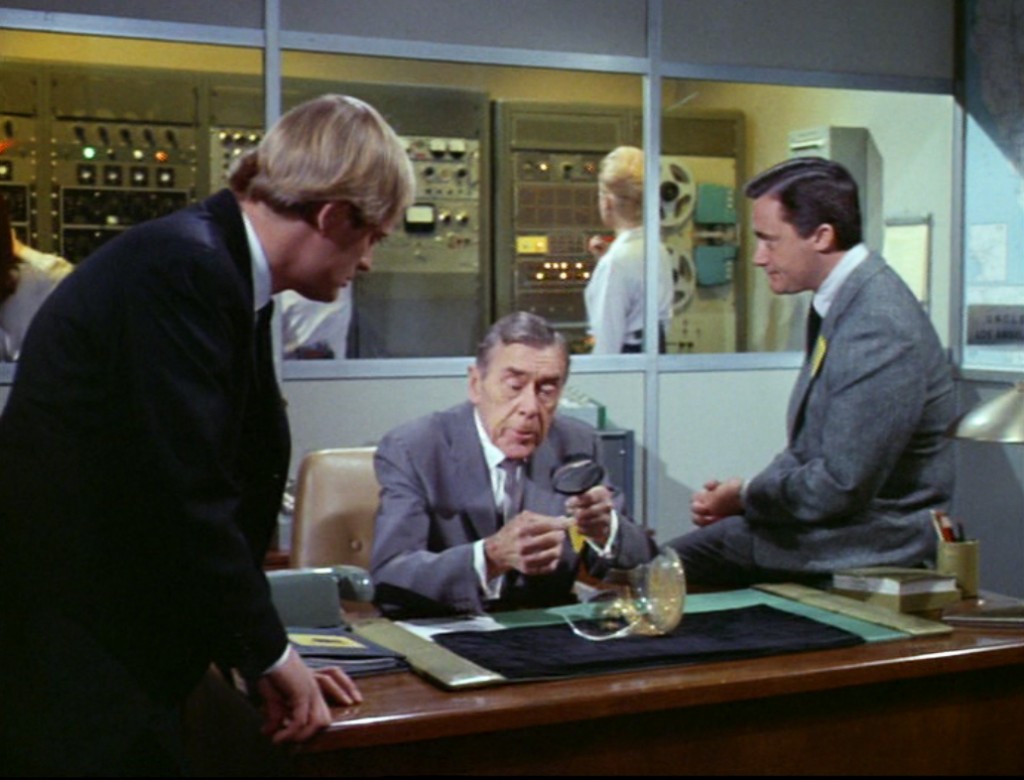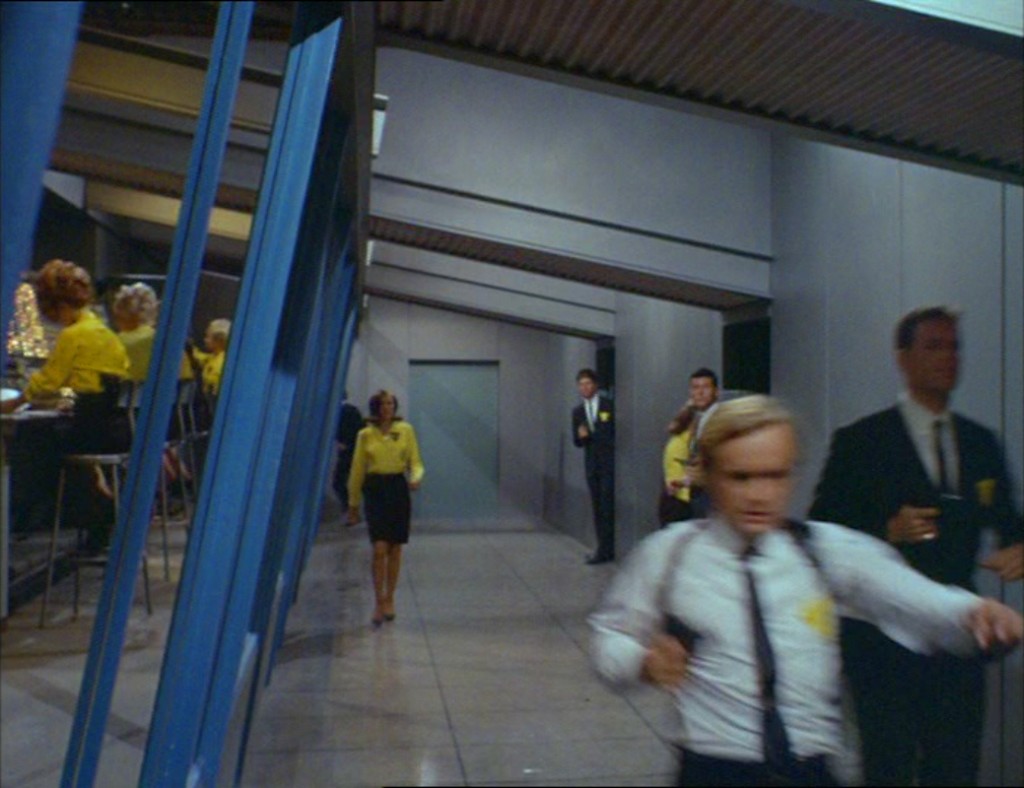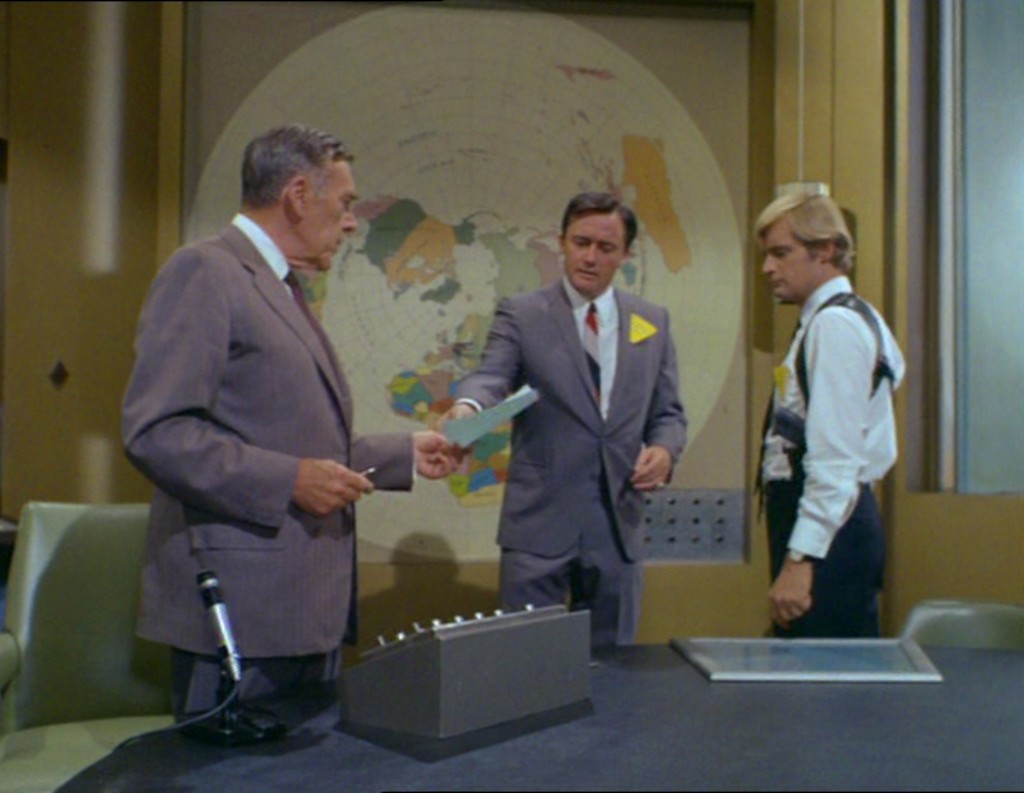The 1960s Man from UNCLE: The definitive guide to furniture and decor in the original film sets. Part 1.
Part 1 of a 5 part series.
The forthcoming and much discussed remake of The Man from U.N.C.L.E (2015) directed by Guy Ritchie with Armie Hammer, Henry Cavill, and Hugh Grant as Kuryakin, Solo and Waverly, is released across the globe from 13th August. In anticipation of the launch, we thought it timely to take a good look at the spectacular decor, interiors, furniture and lighting in the film sets of the much loved and influential original 1960s TV series and their feature film spin offs.

The 105 TV episodes screened between 1964 and 1968 focused on a two-man troubleshooting team working for the secret international espionage and law-enforcement agency U.N.C.L.E. (United Network Command for Law and Enforcement) – the dashing and charismatic Napoleon Solo (Robert Vaughn), and Georgian (Georgia-USSR) Illya Kuryakin (David McCallum). Alexander Waverly, the British head of the organization (Number One of Section One) was played by Leo G. Carroll.
The fictional series achieved such cultural prominence that props, costumes, documents and a video clip are in the Ronald Reagan Presidential Library‘s exhibit on spies and counterspies. U.N.C.L.E. became a major franchise with two dozen novels, a series of comic strip books, board games, Gilbert action figures, Aurora plastic model kits, lunch boxes, toy weapons, a spin-off TV series (The Girl from U.N.C.L.E) and no less than eight feature films.

As the blog Spyvibe aptly points out in their fine article Set for Adventure: “The fantastical movie sets of the 1960s were a sign of an emerging youth culture – playful, lusty, rebellious, modern, and pushing a breakdown between consumer design and Fine Art”.
This is embodied in master set designer (and F&F favourite) Ken Adam‘s work for 1960s Bond “which established the character James Bond in the larger-than-life world of rockets and of evil villains… It was the launch of a new look and feel for entertainment that embodied the times as much as Hefner’s Playboy and the arrival of The Beatles… Repeated and parodied for forty years, Ken Adam’s mixture of expressionism, modern-minimal and high-tech gadgetry remains an irresistible cocktail and defines Spy Vibe design” says the blog.

The Man From U.N.C.L.E. was television’s answer to James Bond and if you’re wondering why the 007 influence is quite so evident then you won’t be surprised to hear that Ian Fleming contributed to the original Man From U.N.C.L.E. concepts. Fleming proposed two characters, Napoleon Solo and April Dancer and the original name was Ian Fleming’s Solo. Solo was to have been the focus, but a scene featuring the Georgian (Georgia-USSR) agent named Illya Kuryakin drew enthusiasm from the fans and the agents were paired. You can read a detailed timeline of how the birth of Bond and Man From Uncle relate to each other here >
David McCallum told the The Express newspaper recently: “We filmed UNCLE [during] a time of international conflict. Viewers loved the idea of working with the Russian agent and the vicarious delight of the teamwork between them” adding that he still gets stopped in the street by people asking about Man from U.N.C.L.E. some fifty years later.
Although originally screened in the 60s, the series firmly stuck in my head together with many other reruns which were brought to our British TV screens in the 80s – from The Avengers (1961) to The Prisoner (1967-68), from The Saint (1962-69) to The Man from U.N.C.L.E. and they all fired my imagination in some way. When I heard that my sister-in-law was working on the new Guy Ritchie version of the film, I took it upon myself to watch many of the original feature films – spin offs from the TV series. Once I’d got past the bizarre plots and the shock of blatant sexism (Good God we’ve come on a long way!), I then started to get hooked, as is often my want, by the film set decoration.

And oh my word what a plethora of 1960s retro modern beauties there are to behold! It’s a time capsule of 60’s fashion and interior design and the Hollywood version of global politics of the day. The production designers and set decorators must have been working on the maximalist principal “more is more” in both number of sets in any one film and in the interior styling which serve to define the life-style and personalities of our globe trotting, crime fighting U.N.C.L.E. agents as well as their counterparts and cohorts. These film sets also indicate the geographical location of each scene, giving distinctive visual clues on where in the world we find our characters who jump from one country to another at pace – from a super high-tech U.N.C.L.E HQ in New York, to a Moroccan palace, to a Japanese Geisha house.

As Elle Decor reminds us : “The 1960s were a time for experimentation…Part reaction against the conformism of the postwar era, part anticipation of the cultural excesses to come. In the real world, people enjoyed free(r) love, Pucci prints, lots of Canadian Club and cigarettes, and participating in the counterculture. The revolution had, indeed, begun…. Decorating shook off its formalism, mixing patterns, time periods, materials, and colours in fresh, breathtaking ways. So much still looks vital, so much is still in production”.
Over a series of 5 feature articles we will look at 4 films in the series: The Spy with My Face (1965), The Karate Killers (1967), The Helicopter Spies (1968) and How to Steal the World (1968). To begin with however, let’s step inside U.N.C.L.E. HQ at various points of all these films.
U.N.C.L.E. HQ
U.N.C.L.E. HQ features throughout the series and is located in a giant skyscraper in New York accessed via a secret entrance through a tailor’s shop leading to a what Spyvibe describes as a “chrome metal madhouse: Swooshing automatic doors, Mr. Waverly’s revolving table and computers lining the hallways all set the scene for many spy movies to follow”. Apparently there are two issues of Files magazine devoted to the technical specs of this building.
Lets take a look at some screen grabs I took of UNCLE HQ from across several films in the series. In the earlier films you will find a backdrop of hard-edged monochrome including grey often metal walls, grey floors and ceilings, epic control panels, early computers taking up entire walls and metal desks – all indicative of the then new vision of the space age.







The monochrome theme continues with strategically placed chairs in black and white such as this Eames LAX 1950s design for Herman Miller in moulded fibre glass or this white stacking chair with holes reminiscent of Robin Days Polo chair.


For a vintage original LAX chair try Modern Vintage, Pamono, Ebay or 1st Dibs.
Find metal desks like the ones below from Bleu Furniture, Elemental, Etsy and 1st Dibs

Giant wall-mounted maps are an essential tool for any espionage control centre and Waverley’s office is no exception (see also F&F article on Goldfinger and The War Room in Dr Strangelove). Outsized maps also appeal to my graphic eye.


Vintage maps can be found from Retro Maps or have one made to size by Surface View.
In later films in the series such as Helicopter Spies and How To Steal the World, the blue grey of the offices are replaced with tones of beige, brown and orange and sage green.




This office scene below features a stunning lemon yellow table lamp (possibly by Gerald Thurston for Lightolier). And clearly the wardrobe department worked closely with the set decorators here to match the uniforms of the women’s blouses.

Find vintage lamps like this from Proper, Fandango Interiors, Alfies Antiques Market and Etsy.
Note: We titled this piece the ‘definitive’ guide as you won’t find much on the internet about U.N.C.L.E. film sets – neither film stills nor analysis in this much detail. And we should know because we’ve been searching for weeks! This series of articles is the result of blood, sweat and several solo tears! To fellow writers and bloggers, that means don’t lift this content without express prior permission and a link please.
Read Part 2 in this series: The Spy With My Face (1965) >
Read Part 3 in this series: The Karate Killers (1967) >
Watch it!
Watch the TV series on iTunes now or order the complete TV series and the feature film spin-offs on DVD – all from our store, or by using the links in the sidebar next to this story (on desktop) or under this story (mobile and tablet).
Other sources for 60s furniture and décor:
Chiswick Auctions host a 20th Century and Contemporary Art and Design Sale, the next one is on 22nd September 2015 – see Chiswick auctions.co.uk.
The Decorative Home and Salvage Show in Cheshire and Lincolnshire.
Panomo
1st Dibs
The Modern Marketplace
Danish Homestore
An excellent reference source for the period is Anne Bony’s book Furniture & Interiors of the 1960s, published in 2004 which you can buy from our store. Other good books covering the 60s include:
Sixties Design by Philippe Carner (Taschen)
Sixties Source Book by Nigel Cawthorne (Quantum Books)
Miller’s Collecting the Sixties (Miller’s)
Sixtiestyle (Middlesex University Press)
David Hicks A Life of Design (Rizzoli)
















 Facebook
Facebook Twitter
Twitter Instagram
Instagram Pinterest
Pinterest RSS
RSS